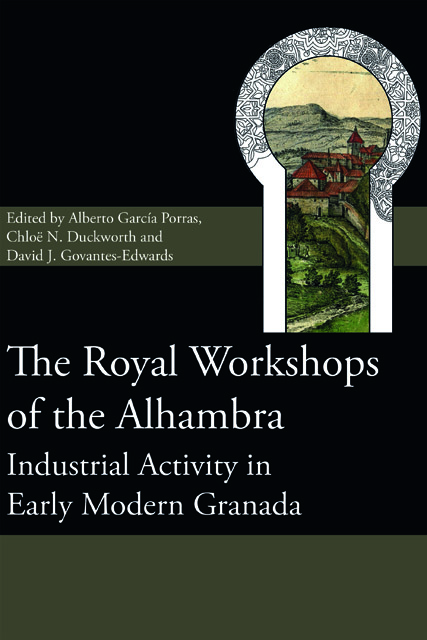Book contents
- Frontmatter
- Contents
- List of Illustrations
- List of Contributors
- Acknowledgements
- Foreword
- Introduction
- 1 The Secano: the city of the Alhambra
- 2 A holistic and reflexive methodology for the archaeological investigation of pyrotechnological activity in the Alhambra
- 3 The modern kilns
- 4 Geophysical and geochemical exploration of the industrial areas in the Alhambra
- 5 The excavation of the area of the Secano in the Alhambra: Trench 1
- 6 The excavation of the area of the Secano in the Alhambra: Trench 2
- 7 The pottery
- 8 Glass in the excavation of the Secano, the Alhambra
- 9 Furnaces at full blast: the demand for architectural ceramics for construction in the Alhambra (16th and 17th centuries)
- Conclusions
- Index
3 - The modern kilns
Published online by Cambridge University Press: 20 December 2023
- Frontmatter
- Contents
- List of Illustrations
- List of Contributors
- Acknowledgements
- Foreword
- Introduction
- 1 The Secano: the city of the Alhambra
- 2 A holistic and reflexive methodology for the archaeological investigation of pyrotechnological activity in the Alhambra
- 3 The modern kilns
- 4 Geophysical and geochemical exploration of the industrial areas in the Alhambra
- 5 The excavation of the area of the Secano in the Alhambra: Trench 1
- 6 The excavation of the area of the Secano in the Alhambra: Trench 2
- 7 The pottery
- 8 Glass in the excavation of the Secano, the Alhambra
- 9 Furnaces at full blast: the demand for architectural ceramics for construction in the Alhambra (16th and 17th centuries)
- Conclusions
- Index
Summary
The current state of preservation of the pyrotechnological structures in the Secano of the Alhambra is not always as clear as could be wished, owing to the aggressive and indiscriminate reconstructions to which they were subjected in the 1960s and 1970s. A better understanding of the structural features of these industrial facilities is essential for the overall understanding of the Nasrid and post-medieval industrial complexes and their integration in the madīna’s urban structure. In order to compile first-hand data about the existing remains, a two-stage programme was implemented (both in trenches 1 and 2 and in the remaining pyrotechnological structures scattered throughout the site). First, the extant structures were examined in detail, paying close attention to such characteristics as construction materials (brick, mortar) and construction techniques to ascertain the actual extent of medieval and post-medieval remains, and record them accordingly. These structures were examined stratigraphically in order to determine phases, reconstructions, and repairs, which can also be indicative of the industrial activities developed within them. Second, the furnaces and kilns were recorded photographically, prior to the production of photogrammetric 3D models, to allow for the remote examination of these structural features in great detail. Moreover, the 3D modelling was not limited to the pyrotechnological structures alone, but extended to the whole trenches, as an extra piece of information with which to examine the complex stratigraphy of both trenches.
Keywords: Archaeological field recording methods; pyrotechnological structures; stratigraphy, medieval and early modern Granada.
Introduction
In recent decades, archaeological research in major Iberian cities has considerably increased our understanding of industrial facilities in the Early Modern Age. However, there is as yet no general overview that goes beyond local perspectives to adopt a broad-lens approach to industrial production strategies during this period. Urban growth in the Late Middle Ages, linked to an extent to the flourishing of commerce, led to far-reaching changes in production models. This is behind the distribution of workshops in the urban layouts and their internal organization, as well as the production of new types of goods.
Pottery production areas are among the best-known industrial facilities dated to between the 15th and 18th centuries, and were predominant in the Secano. During the Early Modern Age, a new pottery production model was to consolidate in the Iberian Peninsula, especially the large-scale production of stanniferous glazes.
- Type
- Chapter
- Information
- The Royal Workshops of the AlhambraIndustrial Activity in Early Modern Granada, pp. 27 - 48Publisher: Boydell & BrewerPrint publication year: 2022

